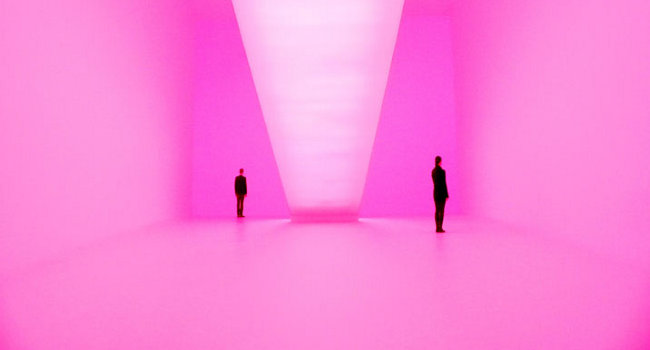Nowadays, contemporary artists aren’t household names. And even in you live in one of those houses where present-day painters, sculptors or new media artists might get the occasional mention, it’s not likely that the name James Turrell would come up.
Turrell is a peer to artists like superstar painter Chuck Close. But, where Close is a decorated hero of the American avant garde, Turrell humbly disappears into work so deep and vast — literally — that his persona resonates with the same sense of mystery that is ever-present in the installations of this “light artist.”
However, all of that is changing — at least for the moment. Turrell is in the middle of a sprawling, three exhibition retrospective of his work, spanning the Los Angeles County Museum of Art, the Museum of Fine Arts in Houston and at the Guggenheim in New York. Turrell is a hard working artist, but one reason for the size of the exhibit is the scale of these projects: Turrell uses space and light to create works that are sculptural and architectural, but that also speak to painting.
It’s a bit hard to grasp from a written account, but this New York Times piece serves as a fine primer on the man and his work. Here are some excerpts:
Not everyone enjoys the Turrell experience. It requires a degree of surrender. There is a certain comfort in knowing what is real and where things are; to have that comfort stripped away can be rapturous, or distressing. It can even be dangerous. During a Turrell show at the Whitney Museum of American Art in 1980, several visitors to a piece called “City of Arhirit” became unsteady in the bright blue haze and tried to brace themselves against a wall made of light. Some of them fell down. A few got hurt. One woman, who broke her arm, sued the Whitney and Turrell for more than $10,000, claiming that the show made her so “disoriented and confused” that she “violently precipitated to the floor.” Another visitor, who sprained her wrist, sued the Whitney for $250,000…Turrell’s greatest work and lifelong fixation is an extinct volcano on his ranch in Arizona, where he has been developing a network of tunnels and underground rooms since 1974. The volcano has a bowl-shaped depression on its top and is known as Roden Crater. Turrell has never opened the crater to the public, and he is guarded about who sees it. An invitation to visit Roden is one of the most coveted tickets in American art…“I was shocked when I got out there,” Chuck Close said. First, that Turrell had made the crater wheelchair-accessible (Close is a wheelchair user.) “He proudly put me in this four-wheel-drive golf cart and drove me all the way up into the thing.” But when they reached the top, Close found another surprise. Turrell has spent years shaping the rim of the caldera in such a way that it seems to distort the contour of the sky. He calls this “celestial vaulting,” and he helped Close lie down to experience the phenomenon. Staring up, Close was struck in equal parts by the power of the illusion and its subtlety. “He’s an orchestrator of experience,” Close said, “not a creator of cheap effects. And every artists knows how cheap an effect is, and how revolutionary an experience.” Close is among the most famous living painters, but when he looks at an artist like Turrell, it sometimes makes him skeptical of his own fame. “It makes me wonder if I’m making pabulum for the masses,” he said with a laugh…
Check out this Turrell segment from the PBS series Art21. The artist provides thoughtful insights into his work and viewers get a birds-eye look at Turrell’s crater.
Please subscribe to my YouTube channel where I archive all of the videos I curate at Insomnia. Click here to check out more art posts.








